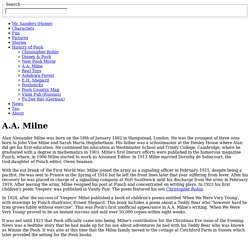

Winnie-the-Pooh. The Pooh stories have been translated into many languages, including Alexander Lenard's Latin translation, Winnie ille Pu, which was first published in 1958, and, in 1960, became the only Latin book ever to have been featured on The New York Times Best Seller list.[1] History Origin Harry Colebourn and Winnie, 1914 Christopher Milne had named his toy bear after Winnie, a Canadian black bear he often saw at London Zoo, and "Pooh", a swan they had met while on holiday.

The bear cub was purchased from a hunter for $20 by Canadian Lieutenant Harry Colebourn in White River, Ontario, Canada, while en route to England during the First World War. But his arms were so stiff ... they stayed up straight in the air for more than a week, and whenever a fly came and settled on his nose he had to blow it off. Ashdown Forest: the setting for the stories The Winnie-the-Pooh stories are set in Ashdown Forest, Sussex, England. The landscapes depicted in E.H. First publication Character Pooh is very social. Film. A. A. Milne. Alan Alexander Milne (/ˈmɪln/; 18 January 1882 – 31 January 1956) was an English author, best known for his books about the teddy bear Winnie-the-Pooh and for various children's poems.

Milne was a noted writer, primarily as a playwright, before the huge success of Pooh overshadowed all his previous work. Biography[edit] Milne joined the British Army in World War I and served as an officer in the Royal Warwickshire Regiment and later, after a debilitating illness, the Royal Corps of Signals. He was recruited into Military Intelligence to write propaganda articles for MI 7b between 1916 and 1918. He was discharged on 14 February 1919,[6] and settled in Mallord Street, Chelsea.[7] Milne married Dorothy "Daphne" de Sélincourt in 1913, and their only son, Christopher Robin Milne, was born in 1920.
During World War II, A. Literary career[edit] 1903 to 1925[edit] After graduating from Cambridge in 1903, A. 1926 to 1928[edit] WikiMiniAtlas 1929 onwards[edit] Legacy and commemoration[edit] Winnie the Pooh. Alan Alexander Milne was born on the 18th of January 1882 in Hampstead, London.

He was the youngest of three sons born to John Vine Milne and Sarah Maria Heginbotham. His father was a schoolmaster at the Henley House where Alan did get his first education. He continued his education at Westminster School and Trinity College, Cambridge, where he graduated with a degree in mathematics in 1903. Milne's first literary efforts were published in the humorous magazine Punch, where, in 1906 Milne started to work as Assistant Editor. In 1913 Milne married Dorothy de Selincourt, the God-daughter of Punch editor, Owen Seaman. With the out break of the First World War, Milne joined the army as a signaling officer in February 1915, despite being a pacifist. In 1924, after the success of 'Vespers' Milne published a book of children's poems entitled 'When We Were Very Young', with drawings by Punch illustrator, Ernest Shepard.
It was not until 1925 that Pooh officially came into being. Pooh Corner - Alan Alexander Milne, Author. Scots by birth, Alan Milne spent his childhood in London, where his father was a preparatory schoolmaster.

His early education owed much to the skills of a young teacher and mentor -- H.G. Wells -- years later, Milne described Wells as "a great writer and a great friend. " He continued his education at Westminster School and Trinity College, Cambridge. He bequethed his original handwritten manuscripts of Winnie-the-Pooh and The House At Pooh Corner to the College Library. While an undergraduate at Cambridge he edited Granta for a year -- his first literary efforts were published in the humourous magazine Punch, where a month after his twenty-fourth birthday he started work as Assistant Editor, remaining there until the outbreak of the First World War. In 1913, Milne married Dorothy Daphne de Selincourt and they had one son, Christopher. Two years later saw the introduction of the Bear of Very Little Brain in Winnie-the-Pooh.